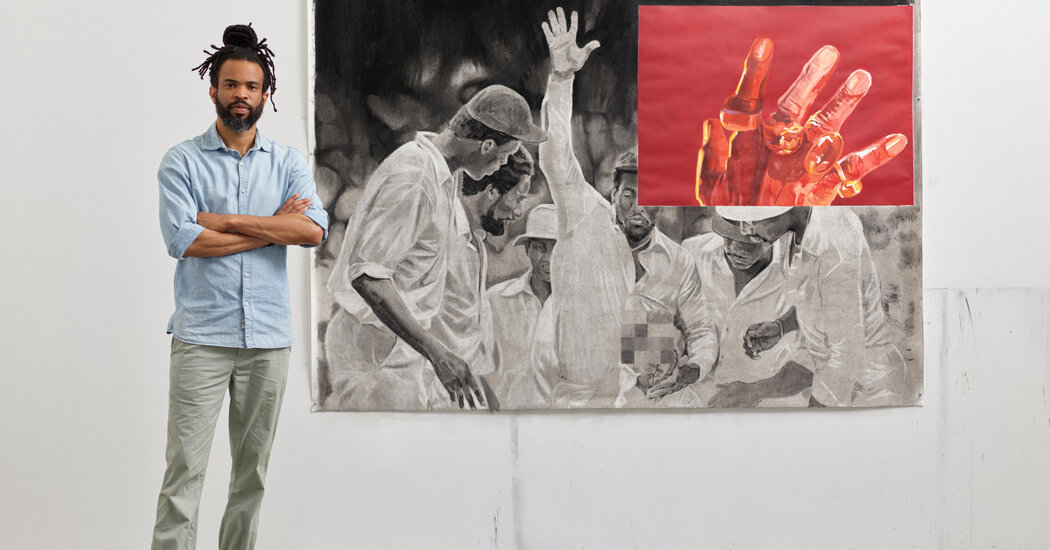Police
Nari Ward and Cosmo Whyte Learn From Each Other

This article is also a weekly newsletter. Sign up for Race/Related here.
Nari Ward vividly remembers when he became an artist. As an immigrant from Jamaica trying to find his place, he recounts seeing a photo of Santa Claus on a blackboard at school. Ward drew a replica and the other kids came over, intrigued, and said, “The new guy is an artist.” Ward claimed that title. “It was a space where I could be different, but there was an excuse for why I was different,” he said.
The Los Angeles-based artist Cosmo Whyte experienced a similar trajectory. Drawing also served as his foundation. He recalled a districtwide painting competition in Jamaica when he was in the fifth grade, and even though his school lost, his painting was so good that it was turned into a limited edition stamp. “I remember being in the art room after school and just loving how art became a sanctuary for me,” Whyte said.
Although from different generations, their approaches are similar. Both Ward and Whyte — born in 1963 and 1982, respectively — create sculptures and installations that pay homage to their Caribbean roots and confront the extensive legacy of resistance against racial injustices, police brutality and colonialism. Their works signify the shared longing for liberation from historical and systemic injustices that have affected Black people globally and individually.
Ward, now based in Harlem, found that integrating these elements in his work symbolized an evolution of his diverse experiences, leading him to contemplate them in relation to his life, family and community. “Initially, I didn’t envision myself within that context; my history didn’t seem to align with this sphere,” Ward said. He believes his perspective has since substantially shifted, particularly when discussing Whyte’s generation. He admires Whyte’s bold approaches, which have allowed him to see how much more room existed for his art now compared to when he began his career.
Whyte’s introduction to the United States was a complicated one — his first day of college was on 9/11. “Being an immigrant in the U.S. during that period was incredibly challenging, dealing with racism and police brutality while witnessing it up close,” he recalled.
The experience prompted many questions for him, as he learned how to navigate this new identity. He first resisted doing any work related to race because he thought he would be pigeonholed. But the more he experienced, the more the subject organically appeared in his work.
Whyte describes his new series as a collaboration with his late father — an architect who left behind an array of unfinished drawings that Whyte is working to complete. His latest work includes expansive steel structures on exhibit at the Anat Ebgi Gallery in Los Angeles. These structures echo his father’s affinity for creating domestic spaces with centralized public yards, an idea rooted in the West African vernacular of communal, multipurpose spaces that were at once private and public.
Even though Black artists are seeing more recognition now, in the past, Ward encountered significant challenges in finding galleries willing to exhibit his work. Whyte is entering a transformative phase because of this increased acceptance, and while he hasn’t fully grasped the extent of his growth, he recognizes this is a significant moment. He wants Black artists to be cautious of how their work is being contextualized as this visibility may come with a different set of challenges.
It’s crucial for both artists to place their work in galleries that collaborate with artists they respect and share a connection with. “Does it make sense for your work to be in conversation with them?” Ward asked.
He emphasized the role of storytelling, citing Whyte’s work as an illustration of how art can capture the significance of both the positive and negative aspects of history. For both artists, their admiration for and understanding of each other’s work is the true power of art.
Whyte’s exhibition, “Hush Now, Don’t Explain,” is on display at the Anat Egbi Gallery until Sept. 16, 2023. Ward’s next exhibition, at the Lehmann Maupin gallery in London, will be open from Nov. 15, 2023, to Jan. 13, 2024.
Invite your friends.
Invite someone to subscribe to the Race/Related newsletter. Or email your thoughts and suggestions to racerelated@nytimes.com.
Read the full article here












You must be logged in to post a comment Login